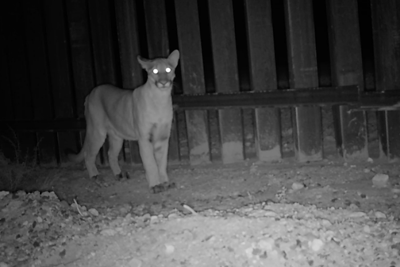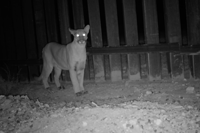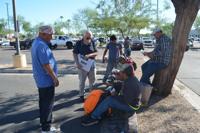
A puma is captured turning back upon encountering the border wall that divides Arizona and Sonora. (Video grab, Ganesh Marín)
Nogales, Arizona – A puma takes a nighttime stroll along its natural habitat in the Arizona desert. Upon reaching the border wall dividing Mexico and the United States, it stops, hisses, waits a few seconds and walks away. A coyote and other wildlife can also be seen in the area, stopping before crossing the border.
These scenes were captured by cameras installed parallel to the border wall by biologist Ganesh Marín as part of a doctoral study at the University of Arizona in Tucson.
Marín, a Mexican biologist, placed nearly 100 wildlife camera traps in the area where New Mexico and Arizona meet, bordering the states of Sonora and Chihuahua in Mexico, and parallel to Federal Highway 2 in Mexico, which connects Ciudad Juárez, Chihuahua, with Tijuana, Baja California. He was tasked with assessing the large animal species, such as bears, jaguars, pumas and bobcats, that constantly move between the countries.
Study of the current border environment, generated by the governments of the United States and Mexico, has increased in recent decades, primarily due to the impact of physical barriers on the region's flora and fauna.
Marín's reports and continued studies extend this line of research by analyzing changes among the area's wildlife inhabitants in response to the ongoing construction of border walls.
The focus of his recently published report is a binational corridor considered one of the backbones of North America, through which populations of bears, pumas, jaguars, coatis and other endangered species, such as the ocelot and the beaver, have historically moved.
The U.S. plans to construct over 24 miles of border wall in that area, known as the San Rafael Valley area.
Marín explained that the question his study addresses is how the border wall will impact the living species in the long run. What he published in a previous study is the first indication of the wall's current impact. The idea moving forward is to predict consequences with the aim of mitigating them, and eventually, when these corridors reopen, identify priority locations to reconnect populations.
How physical barriers impact the movement of species
Marín earned his bachelor's and master's degrees in biology at the Universidad Nacional Autónoma de México (UNAM). He currently works for a nonprofit organization called Conservation Science Partners, where he advances his research.
He began the analysis as part of his doctoral studies in wildlife and conservation at the UA in Tucson, he said.
“When I started my doctorate, that was the idea,” he shared, detailing that the intended focus was on species movement.
“Then the pandemic hit, and when I returned to my field site, half of the corridor I wanted to evaluate was now home to a border. So I had to add this new variable to my project to see how the presence of a border wall is affecting the community of these animals,” Marín said.
It's not simply whether they can cross to the other side, but that the communities on both sides of the wall are completely changing.
“What we found is that, beyond them not being able to cross from one side to the other, the entire community is transforming. We observed that in areas near the U.S.-Mexico border, there are fewer and fewer large animals because there is more human activity,” he indicated.
According to Marín, large animals generally fear humans more because they are persecuted and hunted, such as bears and pumas, which are the top predators in the area. When they are eliminated by humans, the ecosystem is completely altered, he explained.
The construction of walls modifies "the flow of communities that have been moving for thousands and thousands of years, and a vital biological passage for both countries is interrupted," he said.
Analysis of many hours of video reveals several factors that impact animal migration, both in the U.S. and Mexico. For example, some animals reached the border wall and turned back, and on the Mexican side, bears monitored by global positioning systems (GPS) have not crossed because the highway also acts as a barrier.
"We have a double barrier that impedes the movement of wildlife between these two countries," said Marín.
The issue of the border wall continues to generate debate among politicians, conservation groups and impacted populations. While some argue for its importance for national security, others warn of the irreversible impacts on the environment.
For Marín, the important thing is to ensure the construction of a bridge that maintains the flow of species, he asserted, which depends on both countries.
In Texas, there is the Amistad National Recreational Area, where the biological value between the two countries is established and recognized. This area, classified as a "border paradise" by the U.S. National Park Service, is managed as a binational zone that maintains the flow between both species.
That's exactly what they want to see with the project, Marín said — how the community is changing.
César Barrón is an independent reporter covering the transnational communities of Ambos Nogales. He has over 20 years of experience covering the Sonoran communities.















(0) comments
Welcome to the discussion.
Log In
Keep it Clean. Please avoid obscene, vulgar, lewd, racist or sexually-oriented language.
PLEASE TURN OFF YOUR CAPS LOCK.
Don't Threaten. Threats of harming another person will not be tolerated.
Be Truthful. Don't knowingly lie about anyone or anything.
Be Nice. No racism, sexism or any sort of -ism that is degrading to another person.
Be Proactive. Use the 'Report' link on each comment to let us know of abusive posts.
Share with Us. We'd love to hear eyewitness accounts, the history behind an article.